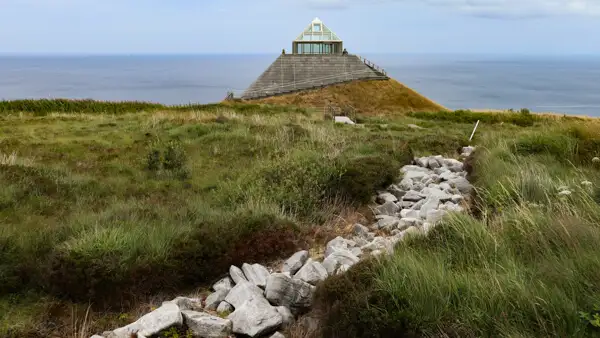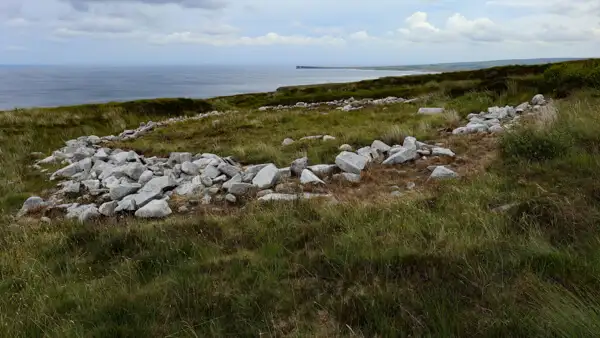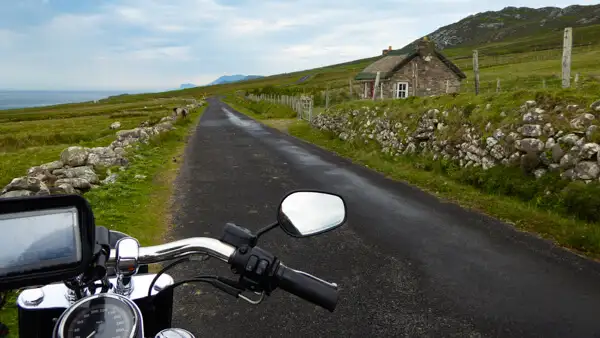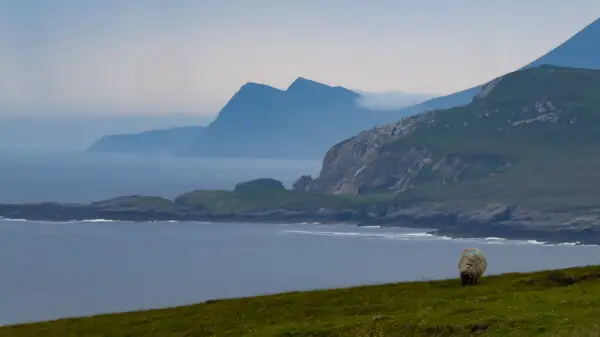If you love peace, solitude and less visited areas, this is the place for you: the North West stands for the original Ireland.
Away from the tourist mainstream, motorbike travellers find peace and relaxation on the wild coasts and in the lonely moors of the North West.
In this episode of our Wild Atlantic Way series, you will find out why Counties Sligo and Mayo are real “insider tips” for motorbike travellers.
Page Contents (click line to jump the text)

The Cèide Fields
Many believe that the Celts are the original inhabitants of Ireland. It is not for nothing that Gaelic (=Celtic) is still actively spoken in many places in Ireland today, especially on the west coast.
In fact, the Celts only came to the island from the mainland around 600 BC.
But the oldest traces of settlement date back to the Stone Age and are already 6000 years old! Who was this original population, where did they come from and how did they live?

Many answers remain hidden in the darkness of history, but some we can find answers to today. And we have the school teacher Patrick Caulfield from the small village of Belderrig (now Belderg) to thank for that!
In the 1930s, houses were still heated with peat. While cutting peat on a hill near the cliffs, the teacher noticed that he kept coming across stone formations that seemed to lie in patterns and were all found at a certain depth.
His son, who became an archaeologist, was then able to solve the mystery and so the oldest settlement in Ireland was discovered and uncovered: Houses, fields, cattle paddocks, gardens, graves and spiritual sites were uncovered. On this mound on the edge of the cliffs, a larger village community once lived.

Today, the Cèide Fields Visitor Centre tells of these early historical settlers. You can take a guided walk to the excavation sites and enjoy the incredible views over the coast from the top of the hill.
The small café-bistro offers refreshments and just outside the car park is a viewpoint overlooking the high, almost vertical, cliffs.

Ballycroy National Park
Few motorbike travellers would probably look for Ballycroy National Park or Wild Nephin National Park.
For walkers and nature lovers, however, it is a popular destination, offering some of the most pristine and unique moorland scenery in Ireland.
It is home to one of the largest rainforests in Europe. The fauna and flora are unique and the streams and river outlets are home to particularly large numbers of salmon and brown trout.
You should at least drive through the National Park on your tour. The N59 runs through the middle of the park and the Visitor Centre is located there. There will be very little traffic in this area and you will have plenty of time and opportunity to enjoy these special landscapes on both sides of the road.
Achill Island
The overlooked gem! There are many beautiful spots along the Wild Atlantic Way, but I find Achill Island particularly impressive!
Many travellers want to drive around the whole island, but only have limited time. Achill Island is a bit out of the way and is often not visited at all – what a shame! The remote areas are particularly beautiful for motorcyclists to ride.
The island is easily accessible via a small bridge. It is highly recommended to drive the whole south island and then come back to the bridge via the north.
Near Kildavnet you will find a square tower, which is the old castle of Grace O`Malley. Grace earned a special place in Irish history as a clan leader, warrior and pirate in the 16th century!

One of the most beautiful viewpoints can be found at the White Cliffs of Ashleam in the very south of the island – this is definitely worth a photo stop!
Keel is a holiday resort and probably the only larger village on the island. Here you will find the long and beautiful sandy beach of Keel Beach with high mountains in the background.
A little further on, you will reach Keem Beach via a very steep and winding little road. The drive over the mountain and the view of the small bay from above are an experience in themselves. Basket sharks (whale sharks) are often sighted in the clear bay from here.
On the way back via the North Loop, you can take a look at the Slievemore Deserted Village and then drive back to the bridge via Golden Strand.

Burrishoole Abbey
On the onward journey, just before Newport, you will find a small sign for Burrishoole Abbey. Find the brake and make a little stop there, because the old ruins of a 15th century abbey are really nice to visit.
The ruins are situated on a small and sheltered sea inlet. This forms a quiet and natural harbour that is still used today. The special location of the abbey with the small fishing boats directly behind it is quite pretty to see.

Further south you can already see the holy mountain Croagh Patrick.
Westport is a good place to spend the night. This nice town has many good B&Bs and restaurants.
Conclusion
Loneliness and beautiful landscapes – that’s a good description of the northwest of the Wild Atlantic Way. In the next episode, we will travel further south along the Wild Atlantic Way to rugged Connemara – rugged, but also better known and busier than Mayo – let us surprise you!
More interesting articles for you
IRELANDS WILD ATLANTIC WAY – PART 5 – MAYO AND CONNEMARA
IRLANDS WILD ATLANTIK WAY – PART 6 – BURREN, CLIFFS OF MOHER AND LOOP HEAD
IRELAND’S WILD ATLANTIC WAY – PART 1 – AN INTRODUCTION TO THE WORLD’S LONGEST COASTAL ROAD
A JOURNEY TO 14 GAME OF THRONES FILMING LOCATIONS IN NORTHERN IRELAND
Photo credits cover photo: Motorcycle at the White Cliffs of Ashleam on Achill Island, photo by Ulrich Knüppel-Gertberg (www.irland-insider.de, www.ireland-insider.com)